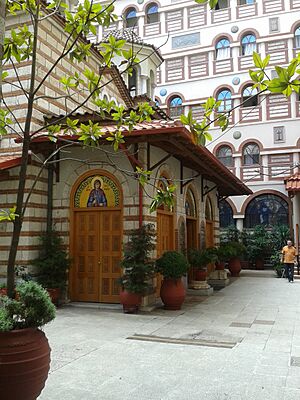Theodora of Thessaloniki facts for kids
Quick facts for kids VenerableTheodora of Thessalonica |
|
|---|---|

Theodora of Thessalonica in a fresco by Dionisius in the Ferapontov Monastery, 1502
|
|
| Born | 812 Aegina, Theme of Hellas, Byzantine Empire |
| Died | 29 August 892 Thessalonica, Theme of Thessalonica, Byzantine Empire |
| Venerated in | Eastern Orthodox Church |
| Major shrine | Thessalonike |
| Feast | 29 August |
Theodora of Thessalonica (Greek: Θεοδώρα Θεσσαλονίκης; 812–892) was a Byzantine nun and saint from Aegina. Her hagiography is the longest ever written about a holy woman in Byzantine history and the Eastern Orthodox Church celebrates her feast day on 29 August.
Biography
According to her biographer, Gregory the Presbyter, Theodora was a native of Aegina. Her father was a senior priest who later took monastic vows, her brother a deacon and her sister a nun. At the age of seven, she learned to read and part of the psalms and was then promised in marriage to a noble man of Aegina. Her early life was profoundly affected by the Arab raids of the ninth and tenth century that devastated the coastal areas of the Aegean. After her brother was killed in one of these raids, she emigrated with her husband and father to Thessalonica, possibly around 826. They moved here as they had several relatives in the city: Aikaterine, abbess of the convent of St. Luke; Anthony, Aikaterine's brother and later also briefly bishop of Thessalonica; Anna, abbess of the convent of St. Stephen; and her sister who was nun at St. Stephen.
Following the death of two of her children, Theodora vowed to dedicate her third child to the monastic life. This daughter, Theophiste, is described as being tonsured and joining the community of her aunt Aikaterina at the age of six though this might be perhaps hagiographic exaggeration. Upon her husband's death in 837, Theodora divided her goods between the poor and the convent of St. Stephen the Protomartyr which she then joined. She then had her daughter transferred to the same community. Mother and daughter were then tasked to work together for fifteen years until Theophiste became the superior and both continued to live in the monastery for twenty-four years. Though Theodora did not perform any miracles during her lifetime or was known for extraordinary feats of asceticism, she was praised for her obedience, hard work and humility.
Theodora died on 29 August 892. Some time after she died, it was decided that her body should be translated from the communal tomb of the nuns to a separate sarcophagus. The hagiographer describes the scene similar to the tomb of Christ. According to Gregory, a group of priests and devout people arrived at the communal grave around midnight and but by a miracle they were unable to roll the tomb stone away. Only after some prayers were they able to open the tomb and place her remains in a sarcophagus from which since then a fragrant and miraculous oil streamed forth. The hagiographer describes several other miracles, including the healing of his own sister, that happened after Theodora's death.
Legacy
Most of her life is known from her biography which was written not long after her death. The multilayered account on her life is the longest hagiographical biography about a holy woman in the Byzantium (around 20,000 words). It also embeds a short biography on Anthony the Confessor, archbishop of Thessalonica, and an anti-iconoclastic discourse spoken by him and addressed to Emperor Leo V the Armenian. The author included many chronological indications about the saints life and appended to the biography additionally to the translation of her relics a list of posthumous miracles. Two versions of the vita survive, one found in a twelfth-century Moscow manuscript and edited by bishop Arsenij and the second preserved in a thirteenth or fourteenth century Vatican manuscript.
Later, during the Palaiologan dynasty, the chartophylax John Staurakos wrote a eulogy of St Demetrios and St Theodora. According to George Sphrantzes, a nun at the nunnery of St Theodora of Thessalonica called Palaiologina also composed canons honouring St Teodora and St Demetrios. It seems that these compositions were part of her personal devotion and not meant for a wider audience which could indicate that a whole body of hymnography of female writers existed of which few would have known.
A painting of her was made after her death in which she was depicted as young and beautiful. This is perhaps either to portray her as others remember her before she entered the nunnery aged 25 or perhaps to emphasize her purity as the beauty of her body and pretty face were associated with modesty and piety. It could also show the sacrifice of her temporal life or indicate that people preferred to venerate young and beautiful images.
Her cult continued during the time of the Turkish occupation and it still continues today in the modern church of St. Theodora which is now part of a male monastery. In August 2010, archaeologists in Thessaloniki discovered a tomb that they tentatively identified as that of Theodora as previously a large three-aisled basilica dedicated to Theodora had been found next to the tomb.
Though her feast day was originally on 29 August, it was moved to 3 August as it was coinciding with the beheading of John the Baptist.
Sources
- "Theodora of Thessalonike". The Oxford Dictionary of Byzantium. (1991). Oxford and New York: Oxford University Press. 2038-2039.


